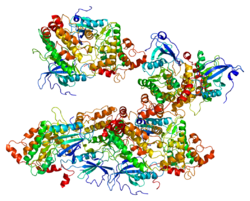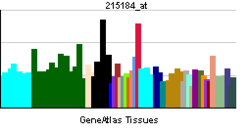- DAPK2
-
Death-associated protein kinase 2 
PDB rendering based on 1wmk.Available structures PDB 1WMK, 1WRZ, 1Z9X, 1ZUZ, 1ZWS, 2A27, 2A2A, 2CKE Identifiers Symbols DAPK2; DRP-1; DRP1; MGC119312 External IDs MGI: 1341297 HomoloGene: 74940 GeneCards: DAPK2 Gene EC number 2.7.11.1 Gene Ontology Molecular function • nucleotide binding
• calmodulin-dependent protein kinase activity
• calmodulin binding
• ATP binding
• identical protein bindingCellular component • cytoplasm Biological process • protein phosphorylation
• apoptosis
• induction of apoptosis
• intracellular protein kinase cascadeSources: Amigo / QuickGO RNA expression pattern 

More reference expression data Orthologs Species Human Mouse Entrez 23604 13143 Ensembl ENSG00000035664 ENSMUSG00000032380 UniProt Q9UIK4 Q8VDF3 RefSeq (mRNA) NM_014326 NM_010019.3 RefSeq (protein) NP_055141 NP_034149.2 Location (UCSC) Chr 15:
64.2 – 64.34 MbChr 9:
66.01 – 66.12 MbPubMed search [1] [2] Death-associated protein kinase 2 is an enzyme that in humans is encoded by the DAPK2 gene.[1][2]
This gene encodes a protein that belongs to the serine/threonine protein kinase family. This protein contains a N-terminal protein kinase domain followed by a conserved calmodulin-binding domain with significant similarity to that of death-associated protein kinase 1 (DAPK1), a positive regulator of programmed cell death. Overexpression of this gene was shown to induce cell apoptosis. It uses multiple polyadenylation sites.[2] The DAPK2 mRNA may undergo alternative splicing to produce a DAPK3-like encoding transcript. [3]
References
- ^ Kawai T, Nomura F, Hoshino K, Copeland NG, Gilbert DJ, Jenkins NA, Akira S (Jun 1999). "Death-associated protein kinase 2 is a new calcium/calmodulin-dependent protein kinase that signals apoptosis through its catalytic activity". Oncogene 18 (23): 3471–80. doi:10.1038/sj.onc.1202701. PMID 10376525.
- ^ a b "Entrez Gene: DAPK2 death-associated protein kinase 2". http://www.ncbi.nlm.nih.gov/sites/entrez?Db=gene&Cmd=ShowDetailView&TermToSearch=23604.
- ^ "New Modularity of DAP-Kinases: Alternative Splicing of the DRP-1 Gene Produces a ZIPk-Like Isoform". http://www.plosone.org/article/info%3Adoi%2F10.1371%2Fjournal.pone.0017344.
Further reading
- Inbal B, Shani G, Cohen O, et al. (2000). "Death-Associated Protein Kinase-Related Protein 1, a Novel Serine/Threonine Kinase Involved in Apoptosis". Mol. Cell. Biol. 20 (3): 1044–54. doi:10.1128/MCB.20.3.1044-1054.2000. PMC 85221. PMID 10629061. http://www.pubmedcentral.nih.gov/articlerender.fcgi?tool=pmcentrez&artid=85221.
- Shani G, Henis-Korenblit S, Jona G, et al. (2001). "Autophosphorylation restrains the apoptotic activity of DRP-1 kinase by controlling dimerization and calmodulin binding". EMBO J. 20 (5): 1099–113. doi:10.1093/emboj/20.5.1099. PMC 145456. PMID 11230133. http://www.pubmedcentral.nih.gov/articlerender.fcgi?tool=pmcentrez&artid=145456.
- Wong TS, Chang HW, Tang KC, et al. (2002). "High frequency of promoter hypermethylation of the death-associated protein-kinase gene in nasopharyngeal carcinoma and its detection in the peripheral blood of patients". Clin. Cancer Res. 8 (2): 433–7. PMID 11839660.
- Chan MW, Chan LW, Tang NL, et al. (2002). "Hypermethylation of multiple genes in tumor tissues and voided urine in urinary bladder cancer patients". Clin. Cancer Res. 8 (2): 464–70. PMID 11839665.
- Inbal B, Bialik S, Sabanay I, et al. (2002). "DAP kinase and DRP-1 mediate membrane blebbing and the formation of autophagic vesicles during programmed cell death". J. Cell Biol. 157 (3): 455–68. doi:10.1083/jcb.200109094. PMC 2173279. PMID 11980920. http://www.pubmedcentral.nih.gov/articlerender.fcgi?tool=pmcentrez&artid=2173279.
- Satoh A, Toyota M, Itoh F, et al. (2002). "DNA methylation and histone deacetylation associated with silencing DAP kinase gene expression in colorectal and gastric cancers". Br. J. Cancer 86 (11): 1817–23. doi:10.1038/sj.bjc.6600319. PMC 2375414. PMID 12087472. http://www.pubmedcentral.nih.gov/articlerender.fcgi?tool=pmcentrez&artid=2375414.
- Strausberg RL, Feingold EA, Grouse LH, et al. (2003). "Generation and initial analysis of more than 15,000 full-length human and mouse cDNA sequences". Proc. Natl. Acad. Sci. U.S.A. 99 (26): 16899–903. doi:10.1073/pnas.242603899. PMC 139241. PMID 12477932. http://www.pubmedcentral.nih.gov/articlerender.fcgi?tool=pmcentrez&artid=139241.
- Gerhard DS, Wagner L, Feingold EA, et al. (2004). "The Status, Quality, and Expansion of the NIH Full-Length cDNA Project: The Mammalian Gene Collection (MGC)". Genome Res. 14 (10B): 2121–7. doi:10.1101/gr.2596504. PMC 528928. PMID 15489334. http://www.pubmedcentral.nih.gov/articlerender.fcgi?tool=pmcentrez&artid=528928.
- Barrios-Rodiles M, Brown KR, Ozdamar B, et al. (2005). "High-throughput mapping of a dynamic signaling network in mammalian cells". Science 307 (5715): 1621–5. doi:10.1126/science.1105776. PMID 15761153.
- Olsen JV, Blagoev B, Gnad F, et al. (2006). "Global, in vivo, and site-specific phosphorylation dynamics in signaling networks". Cell 127 (3): 635–48. doi:10.1016/j.cell.2006.09.026. PMID 17081983.
- Rizzi M, Tschan MP, Britschgi C, et al. (2007). "The death-associated protein kinase 2 is up-regulated during normal myeloid differentiation and enhances neutrophil maturation in myeloid leukemic cells". J. Leukoc. Biol. 81 (6): 1599–608. doi:10.1189/jlb.0606400. PMID 17347302.
PDB gallery 1wmk: Human death-associated kinase DRP-1, mutant S308D d401z9x: Human DRP-1 kinase, W305S S308A D40 mutant, crystal form with 3 monomers in the asymmetric unit1zws: Crystal structure of the catalytic domain of human DRP-1 kinase2a27: Human DRP-1 kinase, W305S S308A D40 mutant, crystal form with 8 monomers in the asymmetric unit2a2a: High-resolution crystallographic analysis of the autoinhibited conformation of a human death-associated protein kinase2cke: HUMAN DEATH-ASSOCIATED DRP-1 KINASE IN COMPLEX WITH INHIBITORCategories:- Human proteins
- Chromosome 15 gene stubs
- Cell signaling
- Signal transduction
Wikimedia Foundation. 2010.






